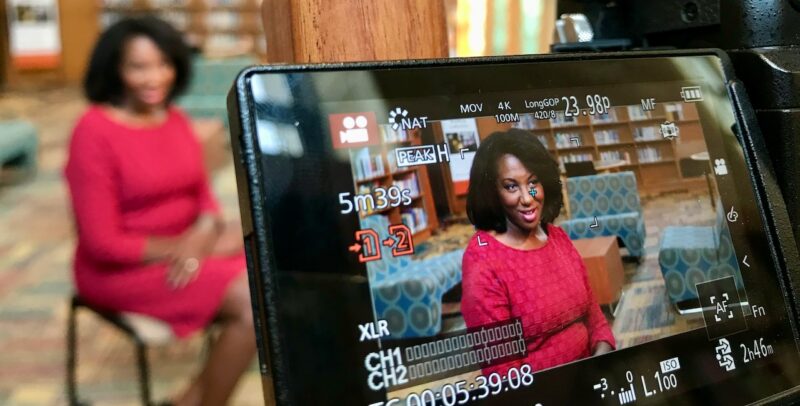Lights, Camera, Impact: the corporate videos book comms pros need
 Back when the pandemic lockdown happened and we went from five customer projects in the hopper to zero overnight, I remember thinking… I have always wanted to write a book.
Back when the pandemic lockdown happened and we went from five customer projects in the hopper to zero overnight, I remember thinking… I have always wanted to write a book.
What can I say? I’m a half-full kind of guy.
Thankfully, our customers started coming back about a month later, and I walked away with book… on my laptop… unpublished.
That’s the way it stayed for two years while I navigated the publishing world, but good news, it’s finally here.
If you’re a fan of our content, you’re likely a communications pro. You work in PR, marketing, or internal communications.
This is a corporate videos book for you.
It’s a blueprint for producing better corporate videos. And here’s the best news, it’s all stuff you as a professional communicator can do.
I encourage you to check out the book webpage to learn more, but I also wanted to give you a little preview. You won’t find this anywhere else.
It’s the book’s introduction.
I hope you enjoy it. I hope you buy the book. I hope it helps you do your job even better than you already do.
Thank you for being a part of the T60 community!
– Tony Gnau
Lights, Camera, Impact:
Storytelling, Branding, and Production Tips for Engaging Corporate Videos
Introduction
TV News is so Glamorous
It was the winter of 2002 at about 5:00 a.m. I was a local television news reporter in Cincinnati, and I was stuck outside, standing in 5℉ weather, waiting to go on live TV. I was called
in early because the temperature was plummeting, and my news director decided we needed team coverage to let people know it was cold outside.
I was not happy.
Neither were the other three reporters who had likewise been called in early to do the same thing. Each of us was tasked with delivering the message that it was cold, that everyone should reconsider heading outside, and that local leaders and health officials
recommended staying home today.
Call me Captain Obvious.
As I stood there losing feeling in my hands and feet, it hit me. I looked at my videographer, who was standing behind the camera, and said, “Mike, if I’m here doing this a year from now, just slap me as hard as you can.”
I had been reporting local news for nearly 10 years, and I just wasn’t into it anymore. My first job in the industry had been as a news and sports reporter in Kearney, Nebraska. That was followed by a similar job in Davenport, Iowa, and next up was Cincinnati, Ohio, where I was a full-time features reporter. But on that day in 2002, freezing my butt off, I knew I was done with TV news.
I was no longer reporting feature stories, which is what I love. People stories. Stories about businesses producing amazing products. Organizations doing inspirational things to make our world a better place. Stories about the people who make this country
great.
Unfortunately, changes in news management at my station brought with them news directors who didn’t value feature stories. They weren’t interested in news that makes people smile or
feel good. They were all about breaking news, and less concerned about telling a good story than getting the story first. It just wasn’t for me.
The big question was, how could I take my passion for stories and get paid for it outside the world of TV news?
 The Ah-ha Moment
The Ah-ha Moment
Days later I was sifting through some file tapes in the newsroom, and I came across a bunch of corporate videos. When you’re a reporter doing a story at a business, its public relations
people will frequently send you the company’s corporate video. This was the collection I had accumulated after visiting companies where I happened to be reporting a story.
It hit me: Someone was getting paid to produce these tapes. (Ugh, I continue to date myself. Video tapes?) Scratch that—someone got paid to produce these terrible stories about these businesses.
They all went something like this:
This is Company X. I’m a professional-sounding Voice over artist who will tell you all about the business. Here’s a list of facts and figures. Now some video of workers who have been staged to do something. Now something about the company’s history, then more facts and figures. Finally, a scripted message from our CEO that was clearly written for them by someone else.
I had always marveled at how bad these were. Did they really think I would use something from these for my story? Forget it!
But now, I saw an opportunity. If whoever had made these was getting paid for it, I’d bet someone who’s really good at storytelling could make a decent living doing this.
At this point in time, the internet was just getting its legs under it. The vast majority of us were still using dial-up modems at home, but it didn’t take a genius to see that speeds would get faster and faster, and that businesses would start using more and more online videos to promote their companies and brands.
So, while I was mulling over a reporting job in a different market, I decided to break away and start my own video production company.
How hard could it be? Said the guy with no business education or experience.
How I Can Help with Amazing Corporate Videos
Years later I’m still here producing videos. I’m the founder and chief storytelling officer at T60 Productions. We’re a small, successful video production company. We got our start in Chicago, are now based in Milwaukee, and have customers from coast to coast. Our projects have sent us to England, Canada, and Hawaii—twice. Someone had to do it.
In the process of transitioning to corporate video, I traded winning TV news Emmy Awards for corporate video Telly Awards.
We’ve produced some awesome stories. I’ve stood on the tarmac at O’Hare shooting video for United Airlines as a plane pulled into the gate. I’ve perched my camera on lava to create a series of educational videos about the endangered Hawaiian monk seal. I got to hang with NBA All-Star Dwyane Wade while producing a video for his youth basketball camp.
And the best part? I didn’t have to stand out in the cold for any of those stories.
I have learned that every company has a story, and I love helping tell it. With this book, I’m here to help you find your stories and tell them in a compelling way. Whether you’re a marketing professional at a small start-up, a solopreneur getting their business off the ground, or a member of the internal communications team at a Fortune 500 company, this book will be your road map for how to produce compelling, effective videos for your company or organization.
We’ll go over where to look for your stories and how to recognize them when they reveal themselves.
We’ll talk about how to create videos on your own and how to involve a pro to make them even better. We’ll cover using video for internal communications and where to work them into your sales and marketing funnel. Finally, we’ll go over an often overlooked and critical aspect of corporate video production—getting people to watch!
Video is one of the most important communications tools businesses and organizations have at their disposal. Audiences are savvy. They know when they’re being sold to and will click away in a heartbeat. You need to get this right, so let’s do this thing. You’re now on
your way to producing better corporate videos.


 Tony Gnau is the Founder and Chief Storytelling Officer at T60 Productions.
He’s a three-time Emmy Award-winning journalist, has led T60 Productions to winning 18 Telly Awards for its corporate videos, and is the author of the Amazon #1 Bestseller “Lights, Camera, Impact: storytelling, branding, and production tips for engaging corporate videos.”
Tony Gnau is the Founder and Chief Storytelling Officer at T60 Productions.
He’s a three-time Emmy Award-winning journalist, has led T60 Productions to winning 18 Telly Awards for its corporate videos, and is the author of the Amazon #1 Bestseller “Lights, Camera, Impact: storytelling, branding, and production tips for engaging corporate videos.”